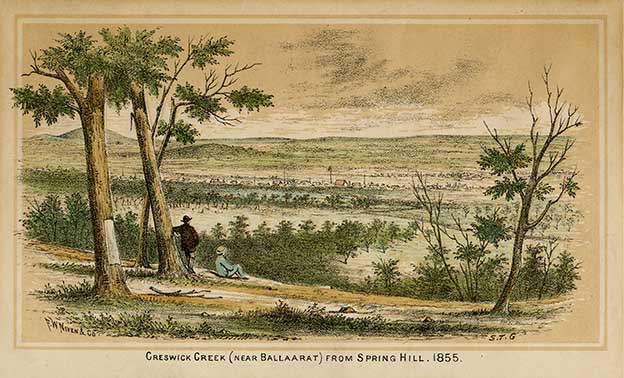William Guthrie Spence
Contents
Background
William Spence was born in 1846, on the Orkney Islands, Northern Scotland. The Spence family emigrated from Scotland in 1852 and settled at Spring Hill, Creswick in 1853. [1]
Spence died in 1926
Goldfields Involvement, 1854
As a young boy Spence was an eyewitness to the events of the Eureka Stockade, claiming to have heard the shooting. Spence started work as a shepherd aged 13, and obtained a miners licence as a 14 year old. [2]
William Guthrie Spence claimed to have been standing on a hill, an eyewitness as a boy of eight on "that 'sad sabbath morn' at Eureka on 3 December 1854". If Spence was at Eureka as a boy, then it follows that he was with his family, namely his father 42 year old James Maxwell Spence, his mother Jane, a 42 year old James (16), John (12), and his sister Ann (4). [3]
Post 1854 Experiences
Spence founded the Australian Workers Union at Jackass Creek near Creswick. Spence was self-educated, a teetotaller and a member of the Creswick Presbyterian Church. In 1874 he started a trade union that became part of the Amalgamated Miners’ Association of Victoria (AMA). In 1878 Spence assisted to bring the Creswick Miners’ Union in the AMA, and was secretary of the Creswick Branch. By 1883 the AMA had nineteen Victorian branches, and around eight thousand members. From 1882 to 1892 Spence was general secretary of the AMA. He broke with the union in 1891-2 over political representation. He formally entered politics in 1998.[4]
Reminiscences
- In his boyhood days Mr Spence said he lived it Creswick and when eight years of age he resided within nine miles of the stockade. He retained vivid memories of the terror that reigned at the time over the collection of the gold licenses by the mounted police who were 'a body of tyran nical bullies performing the work of a rotten, tyrannical Government. The mounted police wee about the lowest class of men that it was possible to find. They were cowardly curs who rode about all day with their swords clanking and when the fight occurred they skulked around the outskirts waiting their opportunity to shoot innocent men "some o£ them boasted after the fight that their swords lind been stained with human blood during fierce encounters but those stains were not the result of any fight on the paet of the police. The cowards who made the boasts had gone about prodding their swords into the dead and wounded bodies of the miners who had fallen in the struggle for justice against tyranny. It was not the golddiggers who had opposed law and order. They had maintained them but the same could not be said of the police or the Government at the time. There were people at the present time who were afraid to express approval of the stockade. This surprised him, as after it it consisted of the sacrifice of life in the cause of de mocracy. To maintain that democracy and to prevent it being stolen from them as some would have it, they would have to be active and vigilant in the future. They had so called progressive Governments that would deprive them of that freedom which had been won at such a sacrifice, and democracy would continue to be in danger until they removed those who were opposed to it.[5]
Newsworthy
- ... Vance Palmer in his fascinating "National Portraits" reveals , that one of the first men to see the possibilities of "unionism was W. C. Spence, a young miner of Creswick. As a .mall boy he had listened to Peter Lalor on Bakery Hill and had watched the red coats assemble for their assault on the Stockade.
- Spence subsequently became one of the most prominent union leaders in Australia being responsible for the formation of the Amalgamated Miners' Association and, later, the Amalgamated Shearers' Union.
- It is not too much to suggest that the memory of that, fateful December morning in 1854, which saw the death of 22 diggers and 6 soldiers, had a considerable influence on W. G. Spence and sparked off some of the crusading zeal which carried him through as a great union leader to the equally dynamic period of the 1890's dominated, as they were, by a new surge of social unrest culminating in the big strikes of that decade.[6]
See also
Further Reading
Corfield, J., Wickham, D., & Gervasoni, C. The Eureka Encyclopaedia, Ballarat Heritage Services, 2004.
References
- ↑ Wickham, D., Gervasoni, C. & Phillipson, W., Eureka Research Directory, Ballarat Heritage Services, 1999.
- ↑ Wickham, D., Gervasoni, C. & Phillipson, W., Eureka Research Directory, Ballarat Heritage Services, 1999.
- ↑ Notes from Val Latimer, 9 December 1995.
- ↑ Wickham, D., Gervasoni, C. & Phillipson, W., Eureka Research Directory, Ballarat Heritage Services, 1999.
- ↑ The Argus, 7 December 1914.
- ↑ Darwin Northern Standard, 2 December 1954.
External links
http://adb.anu.edu.au/biography/goold-james-alipius-3633/text5649
--Clare K. Gervasoni (talk) 22:24, 19 October 2014 (AEDT)
